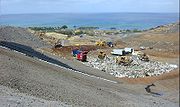A
landfill liner, or
composite landfill liner, is intended to be a low permeable barrier, which is laid down under engineered
landfillA landfill site , is a site for the disposal of waste materials by burial and is the oldest form of waste treatment...
sites. Until it deteriorates, the liner retards migration of
leachateLeachate is any liquid that, in passing through matter, extracts solutes, suspended solids or any other component of the material through which it has passed....
, and its toxic constituents, into underlying
aquiferAn aquifer is a wet underground layer of water-bearing permeable rock or unconsolidated materials from which groundwater can be usefully extracted using a water well. The study of water flow in aquifers and the characterization of aquifers is called hydrogeology...
s or nearby rivers, causing spoiliation of the local water.
Modern landfills generally require a layer of compacted
clayClay is a general term including many combinations of one or more clay minerals with traces of metal oxides and organic matter. Geologic clay deposits are mostly composed of phyllosilicate minerals containing variable amounts of water trapped in the mineral structure.- Formation :Clay minerals...
with a minimum required thickness and a maximum allowable
hydraulic conductivityHydraulic conductivity, symbolically represented as K, is a property of vascular plants, soil or rock, that describes the ease with which water can move through pore spaces or fractures. It depends on the intrinsic permeability of the material and on the degree of saturation...
, overlaid by a high-density polyethylene geomembrane.
The United States Environmental Protection Agency has stated that the barriers "will ultimately fail," while the site remains a threat for "thousands of years," suggesting that modern landfill designs delay but do not prevent ground and surface water pollution.
Chipped or
wasteWaste is unwanted or useless materials. In biology, waste is any of the many unwanted substances or toxins that are expelled from living organisms, metabolic waste; such as urea, sweat or feces. Litter is waste which has been disposed of improperly...
tireA tire or tyre is a ring-shaped covering that fits around a wheel rim to protect it and enable better vehicle performance by providing a flexible cushion that absorbs shock while keeping the wheel in close contact with the ground...
s are used to support and insulate the liner.
Mechanical Properties
The primary forms of mechanical degradation associated with geomembranes result from insufficient tensile strength, tear resistance, impact resistance, puncture resistance, and susceptibility to environmental stress cracking (ESC). The ideal method of assessing the amount of liner degradation would be by examining field samples over their service life. Due to the lengths of time required for field sampling tests, various laboratory-accelerated ageing tests have been developed to measure the important mechanical properties.
Tensile strength
Tensile strength represents the ability for a geomembrane to resist tensile stress. Geomembranes are most commonly tested for tensile strength using one of three methods; the uniaxial tensile test described in ASTM D639-94, the wide-strip tensile test described in ASTM D4885-88, and the multiaxial tension test described in ASTM D5617-94. The difference in these three methods lies in the boundaries imposed into the test specimens. Uniaxial tests do not provide lateral restraint during testing and thus tests the sample under uniaxial stress conditions. During the wide-strip test the sample is restrained laterally while the middle portion is unrestrained. The multiaxial tensile test provides a plane stress boundary condition at the edges of the sample. A typical range of tensile strengths in the machine direction are from 225 to 245 lb/in for 60-mil HDPE to 280 to 325 lb/in for 80-mil HDPE.
Tear resistance
Tear resistance of a geomembrane becomes important when it is exposed to high winds or handling stress during installation. There are various ASTM methods for measuring tear resistance of geomembranes, with most common reports using ASTM D1004. Typical tear resistances show a value of 40 to 45 lb for 60-mil HDPE and 50 to 60 lb for 80-mil HDPE.
Impact resistance
Impact resistance provides an assessment of the effects of impacts from falling objects which can either tear or weaken the geomembrane. As with the previous mechanical properties, there are various ASTM methods for assessment. Significantly higher impact resistances are realized when geotextiles are placed above or below the geomembrane. Thicker geomembranes also display higher impact resistances.
Puncture resistance
Puncture resistance of a geomembrane is important due to the heterogeneous material above and below a typical liner. Rough surfaces, such as stones or other sharp objects, may puncture a membrane if it does not have sufficient puncture resistance. Various methods beyond standard ASTM tests are available; one such method, the critical cone height test, measures the maximum height of a cone on which a compressed geomembrane, which is subjected to increasing pressure, does not fail. HDPE samples typically have a critical cone height of around 1 cm.
Environmental stress cracking
Environmental stress cracking is defined as external or internal cracking in plastic induced by applied tensile stress less than its short-term tensile strength. ESC is a fairly common observation in HDPE geomembranes and thus needs to be evaluated carefully. Proper polymeric properties, such as molecular weight, orientation, and distribution, aid in ESC resistance. ASTM D5397 [standard test method for evaluation of stress crack resistance of polyolefin geomembranes using notched constant tensile load (NCTL)] provides the necessary procedure for measuring the ESC resistance of most HDPE geomembranes. The current recommended transition time for an acceptable HDPE geomembrane is around 100 h.
External links
The source of this article is
wikipedia, the free encyclopedia. The text of this article is licensed under the
GFDL.




